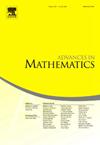On the evolution of structure in triangle-free graphs
IF 1.5
1区 数学
Q1 MATHEMATICS
引用次数: 0
Abstract
We study the typical structure and the number of triangle-free graphs with n vertices and m edges where m is large enough so that a typical triangle-free graph has a cut containing nearly all of its edges, but may not be bipartite.
Erdős, Kleitman, and Rothschild showed that almost every triangle-free graph is bipartite, which leads to an asymptotic formula for the number of triangle-free graphs on n vertices. Osthus, Prömel, and Taraz later showed that for , almost every triangle-free graph on n vertices and m edges is bipartite, which likewise leads to an asymptotic formula for their number. Here we give a precise characterization of the distribution of edges within each part of the max cut of a uniformly chosen triangle-free graph G on n vertices and m edges, for a larger range of densities with . Using this characterization, we describe the evolution of the structure of typical triangle-free graphs as the density changes. We show that as the number of edges decreases below , the following structural changes occur in G:
- •Isolated edges, then trees, then more complex subgraphs emerge as ‘defect edges’, the edges within the parts of a max cut of G. In fact, the distribution of defect edges is first that of independent Erdős-Rényi random graphs inside the parts, then that of independent exponential random graphs, conditioned on a small maximum degree and no triangles.
- •There is a sharp threshold for 3-colorability at and a sharp threshold between 4-colorability and unbounded chromatic number at .
- •Giant components emerge in the defect edges at .
We further use this structural characterization to prove asymptotic formulas for the number of triangle-free graphs with n vertices and m edges in this range of densities. The asymptotic formula exhibits a change in form around the threshold at which giant components emerge among the defect edges.
We likewise prove the analogous results for the random graph conditioned on triangle-freeness.
无三角图中结构的演化
我们研究了具有n个顶点和m条边的无三角形图的典型结构和数量,其中m足够大,使得一个典型的无三角形图有一个包含几乎所有边的切面,但可能不是二部的。Erdős, Kleitman,和Rothschild证明了几乎所有的无三角形图都是二部的,这就得到了n个顶点上无三角形图数目的渐近公式。Osthus, Prömel,和Taraz后来证明,当m≥(1+ε)34n3/2log (n) n时,几乎每一个有n个顶点和m条边的无三角形图都是二部图,这同样得到了二部图数目的渐近公式。在这里,我们给出了在n个顶点和m条边上均匀选择的无三角形图G的最大切割的每个部分内边缘分布的精确表征,对于m=Θ(n3/2log (n))的更大密度范围。利用这一特性,我们描述了典型无三角形图的结构随密度变化的演变。我们表明,当边的数量减少到34n3/2log (n)以下时,G中发生了以下结构变化:•孤立的边,然后是树,然后是更复杂的子图作为“缺陷边”出现,在G的最大切割的部分内的边。事实上,缺陷边的分布首先是部分内的独立Erdős-Rényi随机图的分布,然后是独立指数随机图的分布,条件是最小的最大度和没有三角形。•在m ~ 24n3/2log (n)处存在3色性的明显阈值,在m ~ 14n3/2log (n)处存在4色性和无界色数之间的明显阈值。•在m ~ 14n3/2log (n)处缺陷边缘出现巨大分量。我们进一步利用这个结构表征,证明了在这个密度范围内n个顶点和m条边的无三角形图数目的渐近公式。渐近公式显示出在阈值m ~ 14n3/2log ln n附近的形式变化,在该阈值处,巨大的分量出现在缺陷边缘之间。我们同样证明了在无三角形条件下的随机图G(n,p)的类似结果。
本文章由计算机程序翻译,如有差异,请以英文原文为准。
求助全文
约1分钟内获得全文
求助全文
来源期刊

Advances in Mathematics
数学-数学
CiteScore
2.80
自引率
5.90%
发文量
497
审稿时长
7.5 months
期刊介绍:
Emphasizing contributions that represent significant advances in all areas of pure mathematics, Advances in Mathematics provides research mathematicians with an effective medium for communicating important recent developments in their areas of specialization to colleagues and to scientists in related disciplines.
 求助内容:
求助内容: 应助结果提醒方式:
应助结果提醒方式:


